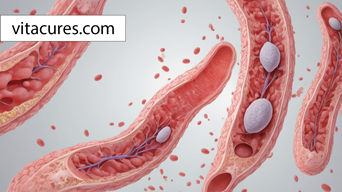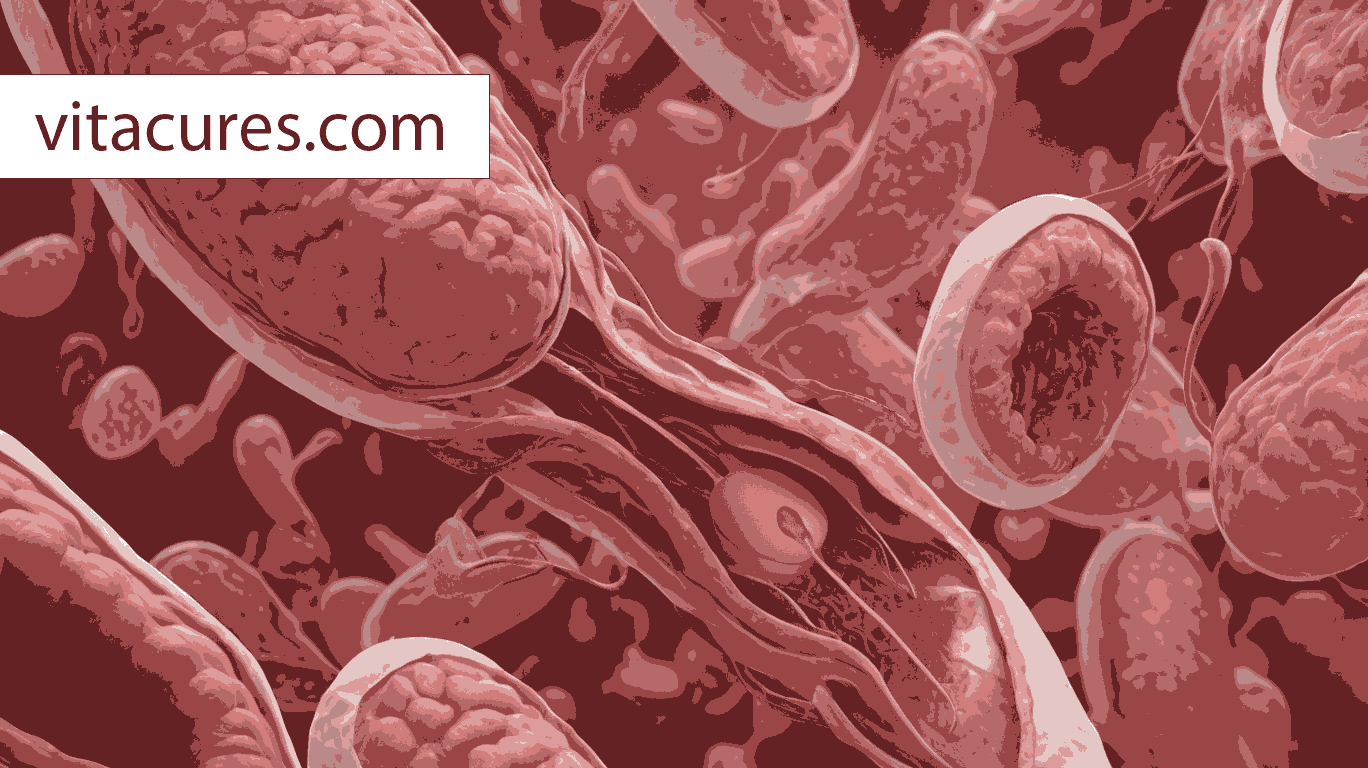Hyperlipidemia is a medical condition characterized by high levels of lipids (fats) in the blood, including cholesterol and triglycerides. This condition can lead to an increased risk of cardiovascular diseases, including heart attacks and strokes.
What is hyperlipidemia?

Hyperlipidemia refers to a medical condition in which there are abnormally high levels of lipids (fats) in the blood, such as cholesterol and triglycerides. These lipids are crucial for various bodily functions, but when their levels become too high, they can lead to serious health issues, particularly related to the heart and blood vessels.
Hyperlipidemia is a medical condition characterized by elevated levels of lipids (fats) in the blood, primarily cholesterol and triglycerides. Lipids play vital roles in the body, such as providing energy and forming cell membranes. However, when lipid levels become too high, they can lead to the buildup of fatty deposits in the blood vessels, increasing the risk of cardiovascular diseases, including heart attacks, strokes, and peripheral artery disease.
Types of Hyperlipidemia
Hyperlipidemia is broadly classified into primary (genetic) and secondary (acquired) types, based on the underlying causes. Each type may affect different lipids in the blood, such as cholesterol or triglycerides. The main types of hyperlipidemia are as follows:
1. Primary Hyperlipidemia (Genetic or Familial)
This form is inherited and often results from genetic mutations that affect lipid metabolism. It is typically more severe than secondary hyperlipidemia. The main types of primary hyperlipidemia include:
- Familial Hypercholesterolemia (FH):
- Characterized by extremely high levels of low-density lipoprotein (LDL) cholesterol, often called “bad” cholesterol.
- Patients are at high risk for early cardiovascular disease.
- There are two types:
- Heterozygous FH: One mutated gene is inherited, leading to high LDL levels but symptoms appear later in life.
- Homozygous FH: Two mutated genes are inherited, leading to extremely high LDL levels from childhood.
- Familial Combined Hyperlipidemia (FCHL):
- Characterized by elevated levels of LDL cholesterol and triglycerides.
- It is the most common inherited lipid disorder and often leads to early-onset cardiovascular disease.
- Familial Hypertriglyceridemia:
- Results in elevated levels of triglycerides, which can increase the risk of developing pancreatitis (inflammation of the pancreas).
- It is generally associated with a family history of high triglycerides and related complications.
- Polygenic Hypercholesterolemia:
- This is caused by multiple genetic factors, leading to moderately high cholesterol levels.
- It is less severe than familial hypercholesterolemia but still increases cardiovascular risk.
2. Secondary Hyperlipidemia (Acquired)
This form of hyperlipidemia is caused by lifestyle factors, medical conditions, or medications that affect lipid levels. Unlike primary hyperlipidemia, it is not inherited but develops due to external factors. Some common causes of secondary hyperlipidemia include:
- Dietary Causes: High intake of saturated fats, trans fats, and cholesterol can raise LDL levels, while excessive alcohol consumption can increase triglycerides.
- Medical Conditions:
- Diabetes mellitus: Poorly controlled diabetes can raise both triglycerides and LDL levels while lowering HDL cholesterol.
- Hypothyroidism: An underactive thyroid can lead to increased LDL cholesterol.
- Kidney disease: Conditions like nephrotic syndrome can elevate lipid levels.
- Liver disease: Liver dysfunction affects lipid metabolism, leading to imbalances.
- Medications:
- Drugs such as corticosteroids, beta-blockers, thiazide diuretics, and oral contraceptives can cause elevated lipid levels as a side effect.
- Obesity and Sedentary Lifestyle: Being overweight or inactive can lead to higher levels of LDL cholesterol and triglycerides, while reducing HDL (good) cholesterol.
3. Mixed Hyperlipidemia
This condition refers to the presence of both high cholesterol and triglyceride levels. It is also known as combined hyperlipidemia and can be caused by either genetic factors (e.g., familial combined hyperlipidemia) or secondary factors (e.g., obesity or diabetes). Mixed hyperlipidemia significantly raises the risk of cardiovascular disease.
4. Hypertriglyceridemia
This form of hyperlipidemia involves primarily elevated triglyceride levels. It can be caused by:
- Genetic factors (familial hypertriglyceridemia).
- Lifestyle factors such as excessive alcohol consumption, obesity, or high-carbohydrate diets.
- Medical conditions such as poorly controlled diabetes or hypothyroidism.
Hypertriglyceridemia increases the risk of pancreatitis and cardiovascular disease.
Summary of Key Types:
- Primary Hyperlipidemia: Genetic causes like familial hypercholesterolemia or familial combined hyperlipidemia.
- Secondary Hyperlipidemia: Due to external factors like poor diet, medical conditions, and medications.
- Mixed Hyperlipidemia: High levels of both cholesterol and triglycerides.
- Hypertriglyceridemia: Primarily elevated triglyceride levels.
Each type of hyperlipidemia poses different risks, with treatment tailored to the specific lipid abnormality and underlying causes.
Causes of Hyperlipidemia
Hyperlipidemia, the condition of elevated lipid levels in the blood, can be caused by a combination of genetic factors, lifestyle choices, and underlying medical conditions. The causes of hyperlipidemia are generally divided into primary (genetic) and secondary (acquired) causes.
1. Primary (Genetic) Causes of Hyperlipidemia
Primary hyperlipidemia is inherited and results from genetic mutations that affect how the body processes lipids. It often leads to higher and earlier elevations of cholesterol or triglycerides compared to secondary causes.
- Familial Hypercholesterolemia (FH):
- A genetic disorder that causes high levels of low-density lipoprotein (LDL) cholesterol from birth. Individuals inherit mutations in genes involved in cholesterol metabolism, leading to high levels of LDL and an increased risk of early-onset heart disease.
- Familial Combined Hyperlipidemia (FCHL):
- A hereditary condition characterized by elevated levels of both LDL cholesterol and triglycerides. It is the most common genetic disorder leading to early cardiovascular disease.
- Familial Hypertriglyceridemia:
- An inherited disorder in which the body overproduces triglycerides, leading to elevated triglyceride levels. This condition is associated with a higher risk of developing pancreatitis (inflammation of the pancreas).
- Polygenic Hypercholesterolemia:
- A more common and less severe form of inherited high cholesterol, resulting from the interaction of multiple genetic factors. It causes moderately elevated LDL cholesterol levels.
2. Secondary (Acquired) Causes of Hyperlipidemia
Secondary hyperlipidemia occurs as a result of external factors such as lifestyle choices, other medical conditions, or medications. These factors can lead to an imbalance in lipid levels, including cholesterol and triglycerides.
Lifestyle Factors
- Diet:
- A diet high in saturated fats, trans fats, and cholesterol can significantly raise LDL cholesterol levels.
- High intake of simple carbohydrates (such as sugary foods) and excessive alcohol consumption can elevate triglyceride levels.
- Obesity:
- Being overweight is a major risk factor for hyperlipidemia, as it increases triglyceride levels and can decrease levels of high-density lipoprotein (HDL), the “good” cholesterol.
- Sedentary Lifestyle:
- Lack of physical activity contributes to high LDL and triglyceride levels, while also lowering HDL cholesterol. Regular exercise helps maintain healthy lipid levels by increasing HDL and lowering LDL and triglycerides.
Medical Conditions
Several medical conditions can disrupt lipid metabolism and contribute to hyperlipidemia:
- Diabetes Mellitus:
- Poorly controlled diabetes, particularly type 2 diabetes, can lead to elevated triglycerides and low HDL cholesterol, contributing to the development of hyperlipidemia.
- Hypothyroidism:
- An underactive thyroid can slow down the metabolism, leading to increased LDL cholesterol levels.
- Chronic Kidney Disease (CKD):
- Kidney diseases, especially nephrotic syndrome, can cause abnormal lipid levels, particularly high cholesterol.
- Liver Disease:
- Conditions like non-alcoholic fatty liver disease (NAFLD) and cirrhosis can disrupt the liver’s role in processing lipids, leading to elevated cholesterol and triglyceride levels.
- Cushing’s Syndrome:
- A disorder caused by high levels of cortisol in the body, leading to increased LDL cholesterol and triglycerides.
- Polycystic Ovary Syndrome (PCOS):
- PCOS is associated with insulin resistance and can lead to increased triglycerides and reduced HDL cholesterol.
Medications
Certain medications can also cause secondary hyperlipidemia as a side effect. These include:
- Corticosteroids (e.g., prednisone): Can elevate both cholesterol and triglyceride levels.
- Beta-blockers: Often used to treat high blood pressure, beta-blockers can raise triglyceride levels and lower HDL cholesterol.
- Thiazide Diuretics: Commonly used to treat hypertension, they may increase LDL cholesterol and triglycerides.
- Oral Contraceptives: Hormonal contraceptives, especially those containing estrogen, can cause elevated triglyceride levels.
- Retinoids (used for acne treatment) and antiretroviral medications (used for HIV treatment) can also raise lipid levels.
3. Other Contributing Factors
- Aging: As people age, their cholesterol levels often rise, particularly LDL cholesterol, due to changes in lipid metabolism.
- Smoking: Tobacco use can lower HDL cholesterol while increasing LDL cholesterol, contributing to an unhealthy lipid profile.
- Alcohol Consumption: Excessive alcohol intake can raise triglyceride levels, sometimes significantly contributing to hypertriglyceridemia.
Hyperlipidemia is a complex condition that can arise from a variety of causes, including genetic predispositions, unhealthy lifestyle choices, and underlying medical conditions. Managing these causes through lifestyle modifications, controlling related health issues, and sometimes using medication can help reduce the risk of complications like cardiovascular disease and pancreatitis.
Symptoms of Hyperlipidemia

Hyperlipidemia, or high levels of lipids (cholesterol and triglycerides) in the blood, typically does not produce noticeable symptoms on its own. It is often referred to as a “silent” condition because most individuals are unaware they have it until complications arise. However, if hyperlipidemia goes untreated, it can lead to more serious conditions that manifest with clear symptoms.
Common Features of Hyperlipidemia:
- No Symptoms Initially:
- Most people with hyperlipidemia experience no overt symptoms in the early stages. It is usually detected through routine blood tests, such as a lipid panel, that measure cholesterol and triglyceride levels.
- Signs of Atherosclerosis (Plaque Buildup in Arteries):
- Over time, high cholesterol, particularly low-density lipoprotein (LDL) cholesterol, can lead to atherosclerosis, the buildup of fatty deposits (plaque) inside the arteries. As atherosclerosis progresses, it can lead to various symptoms:
- Chest pain (angina): Caused by reduced blood flow to the heart.
- Shortness of breath: Also due to limited blood supply to the heart.
- Fatigue: Especially during exertion, due to reduced oxygen delivery to tissues.
- Leg pain or cramping: Known as claudication, this occurs when arteries supplying the legs become narrowed.
- Dizziness or fainting: In severe cases where atherosclerosis affects blood flow to the brain.
- Over time, high cholesterol, particularly low-density lipoprotein (LDL) cholesterol, can lead to atherosclerosis, the buildup of fatty deposits (plaque) inside the arteries. As atherosclerosis progresses, it can lead to various symptoms:
- Xanthomas:
- Some individuals with very high cholesterol levels, particularly those with familial hypercholesterolemia, may develop visible fatty deposits under the skin called xanthomas. These are yellowish patches or lumps that can appear on the:
- Elbows
- Knees
- Buttocks
- Tendons (such as the Achilles tendon)
- Around the eyes (called xanthelasma)
- Some individuals with very high cholesterol levels, particularly those with familial hypercholesterolemia, may develop visible fatty deposits under the skin called xanthomas. These are yellowish patches or lumps that can appear on the:
- Arcus Corneae:
- In individuals with extremely high cholesterol levels, a gray or white ring can form around the cornea (the clear outer layer of the eye). This is called arcus corneae and may indicate cholesterol buildup in the body, although it can also appear with aging.
- Pancreatitis (Related to High Triglycerides):
- Severe hypertriglyceridemia (very high triglyceride levels) can lead to pancreatitis, an inflammation of the pancreas. Symptoms of pancreatitis include:
- Severe abdominal pain (usually in the upper abdomen)
- Nausea and vomiting
- Fever
- Rapid heartbeat
- Severe hypertriglyceridemia (very high triglyceride levels) can lead to pancreatitis, an inflammation of the pancreas. Symptoms of pancreatitis include:
- Cardiovascular Events (Advanced Complications):
- Hyperlipidemia significantly increases the risk of cardiovascular diseases, which can manifest as serious events, including:
- Heart attack: If a plaque ruptures in the coronary arteries, it can block blood flow to the heart, causing symptoms like chest pain, shortness of breath, and sweating.
- Stroke: When plaque buildup affects the arteries leading to the brain, it can result in a stroke, with symptoms such as sudden weakness, confusion, slurred speech, or paralysis.
- Peripheral artery disease (PAD): When blood flow to the limbs is reduced, it can cause leg pain, numbness, or sores that heal slowly.
- Hyperlipidemia significantly increases the risk of cardiovascular diseases, which can manifest as serious events, including:
Treatment of Hyperlipidemia
Treating hyperlipidemia, or high cholesterol, typically involves a combination of lifestyle changes and, if necessary, medication. Here’s a detailed look at the treatment options:
Lifestyle Changes
- Diet: Adopting a heart-healthy diet is crucial. This includes:
- Reducing intake of saturated fats and trans fats
- Eating more fruits, vegetables, whole grains, and lean proteins
- Choosing low-fat or fat-free dairy products
- Limiting red meat and avoiding fried foods
- Exercise: Regular physical activity can help lower cholesterol levels1. Aim for at least 30 minutes of moderate exercise most days of the week.
- Weight Management: Losing excess weight can improve cholesterol levels and overall heart health.
- Quit Smoking: Smoking cessation improves HDL (good) cholesterol levels and reduces the risk of heart disease.
- Limit Alcohol: Drinking alcohol in moderation, if at all, can help manage cholesterol levels.
Medications
If lifestyle changes alone aren’t enough to lower cholesterol levels, your doctor may prescribe medication. Common medications include:
- Statins: These are the most commonly prescribed drugs for lowering LDL (bad) cholesterol.
- Bile Acid Sequestrants: These drugs help lower LDL cholesterol by binding bile acids in the intestines.
- Cholesterol Absorption Inhibitors: These medications reduce the amount of cholesterol absorbed by the body.
- PCSK9 Inhibitors: These newer drugs help lower LDL cholesterol levels significantly.
- Fibrates: These are used to lower triglyceride levels and may also increase HDL cholesterol.
Monitoring and Follow-Up
Regular check-ups with your healthcare provider are essential to monitor cholesterol levels and adjust treatment plans as needed. Your doctor may recommend periodic blood tests to track your progress.
Additional Tips
- Stay Informed: Educate yourself about hyperlipidemia and its management.
- Support Groups: Consider joining a support group for people with high cholesterol to share experiences and tips.
By combining these lifestyle changes and medications, you can effectively manage hyperlipidemia and reduce the risk of heart disease and other complications.
Medicine for Hyperlipidemia
Hyperlipidemia, characterized by elevated levels of lipids (cholesterol and triglycerides) in the blood, is often managed through lifestyle modifications and medications. The primary goals of treatment are to lower cholesterol levels, especially LDL cholesterol (low-density lipoprotein, often referred to as “bad” cholesterol), and to reduce the risk of cardiovascular events such as heart attacks or strokes.
Here are the main types of medications used to treat hyperlipidemia:
1. Statins
Statins are the most commonly prescribed drugs for hyperlipidemia. They work by inhibiting an enzyme involved in cholesterol production in the liver, reducing LDL cholesterol levels and slightly increasing HDL cholesterol (high-density lipoprotein, or “good” cholesterol).
- Examples: Atorvastatin (Lipitor), Simvastatin (Zocor), Rosuvastatin (Crestor)
- Effectiveness: They can reduce LDL cholesterol by 20-50%, depending on the dose.
- Side effects: Muscle pain, liver enzyme changes, and, in rare cases, increased blood sugar levels.
2. Ezetimibe
Ezetimibe works by reducing the absorption of cholesterol in the small intestine, thereby lowering LDL levels. It can be used alone or in combination with statins for enhanced effects.
- Example: Ezetimibe (Zetia)
- Effectiveness: It typically lowers LDL cholesterol by about 18-25%.
- Side effects: Generally well-tolerated, with mild side effects like diarrhea or fatigue.
3. PCSK9 Inhibitors
These are injectable monoclonal antibodies that help the liver remove more LDL cholesterol from the blood by blocking a protein called PCSK9. They are usually prescribed for patients who can’t achieve adequate cholesterol reduction with statins or ezetimibe alone.
- Examples: Alirocumab (Praluent), Evolocumab (Repatha)
- Effectiveness: These can lower LDL cholesterol by up to 60%.
- Side effects: Injection site reactions, flu-like symptoms, or muscle pain.
4. Bile Acid Sequestrants
These medications bind to bile acids in the intestines, preventing their reabsorption. The liver then uses more cholesterol to make new bile acids, reducing the level of cholesterol in the blood.
- Examples: Cholestyramine (Questran), Colesevelam (Welchol)
- Effectiveness: They can lower LDL cholesterol by 10-20%.
- Side effects: Constipation, bloating, and gastrointestinal discomfort.
5. Fibrates
Fibrates primarily reduce triglycerides and may increase HDL cholesterol. They are often prescribed for people with high triglycerides and low HDL levels.
- Examples: Fenofibrate (Tricor), Gemfibrozil (Lopid)
- Effectiveness: They can lower triglycerides by 20-50%.
- Side effects: Muscle pain, gallstones, and liver enzyme elevation.
6. Niacin (Vitamin B3)
Niacin can raise HDL cholesterol and lower triglycerides. It is not as commonly prescribed today due to its side effects and limited additional benefits when added to statins.
- Example: Niacin (Niaspan)
- Effectiveness: It can raise HDL by 15-35% and lower triglycerides by 20-50%.
- Side effects: Flushing, itching, liver toxicity, and increased blood sugar.
7. Omega-3 Fatty Acids
These are commonly used to lower high triglyceride levels. Prescription-strength omega-3 fatty acids are often more effective than over-the-counter supplements.
- Examples: Icosapent ethyl (Vascepa), Omega-3-acid ethyl esters (Lovaza)
- Effectiveness: They can lower triglycerides by 20-50%.
- Side effects: Burping, gastrointestinal upset, and possible bleeding risk at high doses.
8. Bempedoic Acid
A newer drug that lowers cholesterol by inhibiting cholesterol synthesis in the liver, similar to statins but with fewer muscle-related side effects.
- Example: Bempedoic acid (Nexletol)
- Effectiveness: Lowers LDL cholesterol by 15-25%.
- Side effects: Tendon rupture, increased uric acid levels, or gout.
Combination Therapy
In some cases, healthcare providers may prescribe a combination of these drugs to optimize lipid control, particularly in patients at high cardiovascular risk who are not responding adequately to one medication alone.
What is the icd 10 code for hyperlipidemia?

The ICD-10 code for hyperlipidemia is E78.5. This code is used for the diagnosis of “Hyperlipidemia, unspecified,” which refers to elevated levels of lipids in the blood without specifying the exact type (e.g., cholesterol, triglycerides).
If you need more specific codes related to different types of lipid disorders, here are some other relevant ICD-10 codes:
- E78.0: Pure hypercholesterolemia
- E78.1: Pure hyperglyceridemia (elevated triglycerides)
- E78.2: Mixed hyperlipidemia (both cholesterol and triglycerides are elevated)
- E78.3: Hyperchylomicronemia (elevated chylomicrons, a specific type of lipoprotein)
- E78.4: Other hyperlipidemia
Important Considerations:
- Lifestyle modifications: These should always be part of the treatment plan and include dietary changes (reducing saturated fats, increasing fiber, etc.), regular physical activity, weight management, and smoking cessation.
- Regular monitoring: Lipid levels and liver function tests are often monitored to assess treatment efficacy and manage side effects.
Hyperlipidemia icd 10
Below is a comprehensive overview of ICD-10 codes for —hyperlipidemia, including detailed information about each specific code, usage guidelines, and related considerations.
ICD-10 Overview
ICD-10 (International Classification of Diseases, 10th Revision) is a medical classification system used globally to code diagnoses, symptoms, and procedures. For hyperlipidemia, the relevant codes fall under the category E78 – Disorders of Lipid Metabolism.
Primary ICD-10 Codes for Hyperlipidemia
1. E78.0 – Pure Hypercholesterolemia
- Description: Elevated levels of cholesterol in the blood without a significant increase in triglycerides.
- Usage:
- Use when only cholesterol levels are elevated.
- Applicable for conditions like familial hypercholesterolemia.
- Examples:
- A patient with high LDL (Low-Density Lipoprotein) cholesterol but normal triglycerides.
- Familial hypercholesterolemia type I.
2. E78.1 – Pure Hyperglyceridemia
- Description: Elevated levels of triglycerides in the blood without a significant increase in cholesterol.
- Usage:
- Use when only triglyceride levels are elevated.
- Examples:
- A patient with high triglycerides due to uncontrolled diabetes or alcohol use, but normal cholesterol levels.
3. E78.2 – Mixed Hyperlipidemia
- Description: Simultaneous elevation of cholesterol and triglycerides in the blood.
- Usage:
- Use when both cholesterol and triglyceride levels are elevated.
- Examples:
- A patient with both high LDL cholesterol and high triglycerides, often seen in metabolic syndrome.
4. E78.3 – Hyperchylomicronemia
- Description: Elevated levels of chylomicrons (a type of lipoprotein) in the blood.
- Usage:
- Use for disorders characterized by extremely high triglycerides due to chylomicron accumulation.
- Examples:
- Familial chylomicronemia syndrome.
- Acute pancreatitis secondary to hyperchylomicronemia.
5. E78.4 – Other Hyperlipidemia
- Description: Hyperlipidemia that does not fall into the categories of E78.0–E78.3.
- Usage:
- Use for lipid disorders not specifically classified elsewhere.
- Examples:
- Elevated lipoprotein(a) levels.
- Other rare lipid metabolism disorders.
6. E78.5 – Hyperlipidemia, Unspecified
- Description: Elevated lipid levels without further specification of the type.
- Usage:
- Use when the type of hyperlipidemia is not clearly documented or specified.
- Commonly used in general screenings where detailed lipid profiles are not provided.
- Examples:
- A routine check-up showing elevated cholesterol or triglycerides without detailed breakdown.
- Initial diagnosis before further testing.
Additional Relevant ICD-10 Codes
While E78.0–E78.5 cover most hyperlipidemia cases, other related codes might be relevant depending on the clinical scenario:
- E78.8 – Other Disorders of Lipid Metabolism
- Description: Includes specific lipid disorders not captured by E78.0–E78.5.
- Examples:
- Tangier disease (a rare inherited disorder characterized by very low HDL cholesterol).
- Familial dysbetalipoproteinemia.
- E78.9 – Disorder of Lipid Metabolism, Unspecified
- Description: General lipid metabolism disorder without further specification.
- Usage:
- When lipid metabolism disorder is present but not further classified.
- Note: Similar to E78.5 but broader; often used interchangeably based on documentation.
Guidelines for Selecting the Appropriate ICD-10 Code
- Specificity is Key:
- Always aim to use the most specific code available based on the patient’s clinical documentation.
- Detailed lipid profiles help in selecting between E78.0, E78.1, E78.2, etc.
- Use Unspecified Codes When Necessary:
- If documentation lacks specificity regarding which lipids are elevated, use E78.5 or E78.9.
- Ensure that further diagnostic testing is pursued to allow for more precise coding in future encounters.
- Consider Underlying Causes:
- If hyperlipidemia is secondary to another condition (e.g., hypothyroidism, diabetes mellitus), consider coding both the underlying condition and hyperlipidemia separately as per coding guidelines.
- Associated Complications:
- If hyperlipidemia has led to complications like atherosclerosis (I70.90 – Atherosclerosis, unspecified, without heart involvement) or pancreatitis (K85 – Acute Pancreatitis), ensure these are also coded.
- Avoid Coding Not Otherwise Specified (NOS) When Possible:
- Always strive for precise coding to enhance data accuracy, patient care, and billing processes.
Coding Tips and Best Practices
- Thorough Documentation:
- Encourage comprehensive clinical documentation specifying which lipids are elevated to facilitate accurate coding.
- Regular Updates:
- Stay informed about updates to ICD-10 codes, as new codes may be introduced, and existing ones may be redefined.
- Training and Resources:
- Utilize coding manuals, official guidelines from the Centers for Medicare & Medicaid Services (CMS), and resources like the ICD-10-CM Official Guidelines for Coding and Reporting.
- Clinical Validation:
- Ensure that the selected ICD-10 code aligns with clinical findings and laboratory results.
- Avoid Code Upcoding:
- Do not assign a more specific code than what is supported by the documentation.
Examples of Code Application
- Example 1:
- Patient: 55-year-old male with high LDL cholesterol levels (240 mg/dL) and normal triglycerides.
- Appropriate Code: E78.0 – Pure Hypercholesterolemia
- Example 2:
- Patient: 40-year-old female with elevated triglycerides (300 mg/dL) due to uncontrolled diabetes.
- Appropriate Code: E78.1 – Pure Hyperglyceridemia
- Additional Code: E11.65 – Type 2 diabetes mellitus with hyperglycemia (if applicable)
- Example 3:
- Patient: 60-year-old patient with both high cholesterol and triglycerides.
- Appropriate Code: E78.2 – Mixed Hyperlipidemia
- Example 4:
- Patient: 30-year-old with familial chylomicronemia.
- Appropriate Code: E78.3 – Hyperchylomicronemia
- Example 5:
- Patient: 45-year-old with elevated lipoprotein(a) levels not specified further.
- Appropriate Code: E78.4 – Other Hyperlipidemia
- Example 6:
- Patient: Routine screening shows elevated cholesterol without detailed lipid profile.
- Appropriate Code: E78.5 – Hyperlipidemia, Unspecified
Related Clinical Considerations
- Comorbid Conditions: Hyperlipidemia often coexists with other conditions such as hypertension, diabetes mellitus, and cardiovascular diseases. Accurate coding should reflect all relevant diagnoses.
- Treatment and Management:
- Documenting the diagnosis accurately is crucial for appropriate management and reimbursement for lipid-lowering therapies.
- Preventive Services:
- Screening for hyperlipidemia is part of preventive care; ensure that preventive service codes are used alongside diagnostic codes when applicable.
- Insurance and Reimbursement:
- Accurate ICD-10 coding ensures proper billing and reimbursement for healthcare services related to hyperlipidemia management.
Resources for Further Information
- Centers for Medicare & Medicaid Services (CMS) ICD-10-CM Official Guidelines for Coding and Reporting:
- World Health Organization (WHO) ICD-10 Codes:
- American Medical Association (AMA) CPT and ICD-10 Resources:
Mixed hyperlipidemia
Mixed Hyperlipidemia is a type of dyslipidemia characterized by elevated levels of both cholesterol and triglycerides in the blood. This condition increases the risk of cardiovascular diseases, including heart attacks and strokes. Below is a comprehensive overview of mixed hyperlipidemia, including its definition, causes, diagnosis, treatment options, associated ICD-10 codes, and related considerations.
1. What is Mixed Hyperlipidemia?
Mixed Hyperlipidemia refers to the simultaneous elevation of multiple types of lipids in the blood, typically including:
- Low-Density Lipoprotein Cholesterol (LDL-C): Often termed “bad” cholesterol, high levels contribute to plaque buildup in arteries.
- Triglycerides: A type of fat in the blood, elevated levels can lead to pancreatitis and are associated with metabolic syndrome.
- Sometimes, Elevated Very Low-Density Lipoprotein (VLDL): Another type of lipoprotein that carries triglycerides.
Mixed hyperlipidemia is commonly associated with Metabolic Syndrome, which includes a cluster of conditions like insulin resistance, hypertension, obesity (particularly central adiposity), and impaired glucose tolerance.
2. Causes and Risk Factors
Primary Causes:
- Genetic Factors: Familial combined hyperlipidemia is an inherited disorder leading to elevated cholesterol and triglycerides.
- Metabolic Disorders: Conditions like diabetes mellitus and hypothyroidism can disrupt lipid metabolism.
Secondary Causes:
- Lifestyle Factors:
- Diet: High intake of saturated fats, trans fats, and simple carbohydrates can elevate lipid levels.
- Physical Inactivity: Lack of exercise is linked to increased LDL-C and triglycerides.
- Obesity: Especially central obesity, contributes to dyslipidemia.
- Excessive Alcohol Consumption: Can raise triglyceride levels.
- Medical Conditions:
- Type 2 Diabetes Mellitus: Insulin resistance affects lipid metabolism.
- Chronic Kidney Disease: Alters lipid profiles.
- Liver Diseases: Affect lipid synthesis and clearance.
- Medications:
- Beta-Blockers
- Diuretics
- Steroids
- Antipsychotics
3. Symptoms and Clinical Presentation
Mixed hyperlipidemia is typically asymptomatic and often discovered through routine blood tests. However, complications arising from prolonged elevated lipid levels can present with:
- Xanthomas: Deposits of cholesterol in the skin or tendons.
- Xanthelasma: Cholesterol deposits around the eyes.
- Pancreatitis: Especially in cases with very high triglycerides.
- Coronary Artery Disease: Manifesting as chest pain or heart attacks.
- Peripheral Artery Disease: Causing pain in limbs during exertion.
4. Diagnosis
Laboratory Tests:
- Lipid Panel: Measures total cholesterol, LDL-C, HDL-C (High-Density Lipoprotein Cholesterol), and triglycerides.
- Criteria for Mixed Hyperlipidemia:
- Elevated LDL-C (typically >160 mg/dL)
- Elevated triglycerides (typically >200 mg/dL)
- Low HDL-C (<40 mg/dL for men, <50 mg/dL for women)
- Criteria for Mixed Hyperlipidemia:
Additional Assessments:
- Apolipoprotein B Levels: Higher in mixed hyperlipidemia.
- Lipoprotein(a) Levels: May be elevated.
- Genetic Testing: For familial forms of dyslipidemia.
- Assessment for Secondary Causes: Thyroid function tests, liver function tests, blood glucose levels.
Risk Assessment Tools:
- Framingham Risk Score
- ASCVD Risk Calculator
These tools help estimate the 10-year risk of cardiovascular events and guide treatment decisions.
5. Treatment
A. Lifestyle Modifications
Lifestyle changes are foundational and often the first step in managing mixed hyperlipidemia.
- Dietary Changes:
- Reduce Saturated and Trans Fats: Limit red meat, full-fat dairy, and processed foods.
- Increase Fiber Intake: Incorporate fruits, vegetables, whole grains, and legumes.
- Limit Simple Carbohydrates and Sugars: Reduce intake of sugary beverages and snacks.
- Include Healthy Fats: Such as those found in fish, nuts, and olive oil.
- Physical Activity:
- Regular Exercise: Aim for at least 150 minutes of moderate-intensity aerobic activity per week.
- Weight Management:
- Achieve and Maintain a Healthy Weight: Weight loss can significantly improve lipid profiles.
- Smoking Cessation:
- Stop Smoking: Improves HDL-C levels and reduces cardiovascular risk.
- Alcohol Moderation:
- Limit Alcohol Intake: Especially important for managing triglycerides.
B. Pharmacological Therapy
When lifestyle modifications are insufficient, medications are employed to manage lipid levels.
1. Statins
- Mechanism: Inhibit HMG-CoA reductase, reducing cholesterol synthesis.
- Examples: Atorvastatin, Simvastatin, Rosuvastatin.
- Effect: Lower LDL-C by 20-50%; modest triglyceride reduction.
- Indication: First-line therapy for mixed hyperlipidemia, especially with high cardiovascular risk.
2. Fibrates
- Mechanism: Activate PPAR-alpha receptors, increasing triglyceride clearance and HDL-C.
- Examples: Fenofibrate, Gemfibrozil.
- Effect: Lower triglycerides by 20-50%; modest HDL-C increase.
- Indication: Particularly useful when triglycerides are significantly elevated.
3. Niacin (Vitamin B3)
- Mechanism: Decreases hepatic synthesis of VLDL, thereby lowering LDL-C and triglycerides while raising HDL-C.
- Example: Niacin extended-release (Niaspan).
- Effect: Can lower triglycerides by up to 50% and increase HDL-C by up to 35%.
- Considerations: Limited use due to side effects like flushing and potential liver toxicity.
4. Ezetimibe
- Mechanism: Inhibits intestinal absorption of cholesterol.
- Example: Ezetimibe (Zetia).
- Effect: Lowers LDL-C by ~18-25%.
- Use: Often combined with statins for additive effect.
5. PCSK9 Inhibitors
- Mechanism: Monoclonal antibodies that increase LDL receptor availability.
- Examples: Alirocumab (Praluent), Evolocumab (Repatha).
- Effect: Lower LDL-C by up to 60%; some triglyceride reduction.
- Use: For patients with familial hypercholesterolemia or those who cannot achieve lipid goals with other therapies.
6. Bempedoic Acid
- Mechanism: Inhibits ATP citrate lyase, an enzyme involved in cholesterol synthesis.
- Example: Bempedoic acid (Nexletol).
- Effect: Lowers LDL-C by 15-25%.
- Use: As an adjunct to statins or for patients intolerant to statins.
7. Omega-3 Fatty Acids
- Mechanism: Reduce hepatic triglyceride synthesis.
- Examples: Icosapent ethyl (Vascepa), Omega-3-acid ethyl esters (Lovaza).
- Effect: Lower triglycerides by 20-50%.
- Use: For patients with high triglycerides despite other therapies.
C. Combination Therapy
In many cases, a combination of medications may be necessary to achieve target lipid levels, especially in patients with mixed hyperlipidemia who have multiple lipid abnormalities.
- Examples:
- Statin + Ezetimibe: For enhanced LDL-C reduction.
- Statin + Fibrate: To address both LDL-C and triglycerides, though caution is needed due to increased risk of myopathy.
- Statin + PCSK9 Inhibitor: For maximal LDL-C lowering.
6. ICD-10 Coding for Mixed Hyperlipidemia
Accurate ICD-10 coding is essential for clinical documentation, billing, and epidemiological tracking. For mixed hyperlipidemia, the relevant ICD-10 code is:
E78.2 – Mixed Hyperlipidemia
- Description: Simultaneous elevation of cholesterol and triglycerides in the blood.
- Usage:
- Primary Diagnosis: When both cholesterol and triglyceride levels are elevated.
- Clinical Scenarios:
- A patient with high LDL-C (e.g., >160 mg/dL) and elevated triglycerides (e.g., >200 mg/dL).
- Metabolic syndrome with dyslipidemia features.
- Exclusions:
- Use specific codes (E78.0, E78.1, etc.) if the lipid abnormality is purely one type.
- Do not use E78.2 if the hyperlipidemia is secondary to another condition; code both the primary condition and hyperlipidemia separately.
Additional Related ICD-10 Codes:
- E78.0: Pure hypercholesterolemia
- E78.1: Pure hyperglyceridemia
- E78.3: Hyperchylomicronemia
- E78.4: Other hyperlipidemia
- E78.5: Hyperlipidemia, unspecified
- E78.8: Other disorders of lipid metabolism
- E78.9: Disorder of lipid metabolism, unspecified
Coding Guidelines:
- Specificity: Use the most specific code based on laboratory results and clinical documentation.
- Secondary Conditions: If mixed hyperlipidemia is due to another condition (e.g., diabetes), ensure both are coded.
- Avoid Upcoding: Do not assign a more specific code without supporting documentation.
- Comorbidities and Complications: Code all relevant diagnoses, such as atherosclerosis or pancreatitis if present.
7. Management Considerations
A. Monitoring and Follow-Up
- Regular Lipid Panels: To assess treatment efficacy and adjust therapies.
- Liver Function Tests: Especially when on statins or niacin.
- Kidney Function Tests: If on fibrates or PCSK9 inhibitors.
- Monitoring for Side Effects: Such as muscle pain from statins or gastrointestinal issues from fibrates.
B. Addressing Comorbid Conditions
- Diabetes Management: Tight glycemic control can improve lipid profiles.
- Hypertension Control: Reduces overall cardiovascular risk.
- Weight Loss Programs: Integrated with dietary and physical activity interventions.
C. Patient Education
- Understanding Medications: Importance of adherence and awareness of potential side effects.
- Lifestyle Modification: Empowering patients to make sustainable changes.
- Risk Awareness: Educating about the implications of uncontrolled hyperlipidemia.
8. Complications of Mixed Hyperlipidemia
- Atherosclerosis: Plaque buildup in arteries leading to coronary artery disease, stroke, and peripheral artery disease.
- Pancreatitis: Particularly with very high triglyceride levels (>1000 mg/dL).
- Non-Alcoholic Fatty Liver Disease (NAFLD): Associated with metabolic syndrome.
- Xanthomas and Xanthelasmas: Cholesterol deposits in tissues.
9. Prognosis
With appropriate management, including lifestyle changes and pharmacotherapy, individuals with mixed hyperlipidemia can significantly reduce their risk of cardiovascular events. Early detection and comprehensive treatment are key to improving long-term outcomes.
10. Related Clinical Guidelines and Resources
- American College of Cardiology (ACC) / American Heart Association (AHA): Provides guidelines on cholesterol management.
- National Lipid Association (NLA): Offers resources and recommendations for lipid disorders.
- Centers for Disease Control and Prevention (CDC): Information on lipid disorders and public health strategies.
- CDC Lipid Disorders
- World Health Organization (WHO): ICD-10 classification details.
11. Summary
Mixed Hyperlipidemia is a significant risk factor for cardiovascular diseases, characterized by elevated levels of both cholesterol and triglycerides. Effective management requires a combination of lifestyle modifications and pharmacological treatments tailored to the individual’s lipid profile and overall health status. Accurate ICD-10 coding, specifically E78.2, is essential for proper documentation, treatment planning, and reimbursement processes. Collaboration with healthcare providers, regular monitoring, and patient education are critical components in mitigating the risks associated with mixed hyperlipidemia.
Note: Always consult with a healthcare professional for personalized medical advice and treatment plans.
How to Find the Correct ICD-10 Code for Hyperlipidemia?
- Review Patient’s Medical Records
- Obtain Detailed Lipid Profile Results
- Identify Specific Type of Hyperlipidemia
- Consult ICD-10 Coding Manuals or Software
- Verify with Clinical Documentation
- Seek Assistance from Medical Coders if Needed
Why is accurate coding important for hyperlipidemia?
- Ensures Proper Billing and Reimbursement
- Facilitates Accurate Medical Records
- Supports Quality Patient Care
- Enables Reliable Epidemiological Tracking
- Complies with Regulatory Requirements
- Aids in Healthcare Analytics and Reporting
What are the common types of hyperlipidemia in ICD-10?
- E78.0 – Pure Hypercholesterolemia
- E78.1 – Pure Hyperglyceridemia
- E78.2 – Mixed Hyperlipidemia
- E78.3 – Hyperchylomicronemia
- E78.4 – Other Hyperlipidemia
- E78.5 – Hyperlipidemia, Unspecified
How does hyperlipidemia coding impact patient care?
- Accurate Diagnosis and Treatment Plans
- Efficient Insurance Claims Processing
- Enhanced Communication Among Healthcare Providers
- Improved Monitoring of Treatment Outcomes
- Facilitates Access to Necessary Medications
- Supports Preventive Care Initiatives



